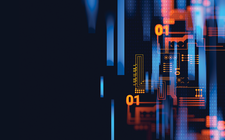Fuzzing and the quest for safer software
The Buzz on Fuzz

Fuzzing is an important method for finding bugs and security vulnerabilities in software. Read on to find out what fuzzing is and which methods are commonly used today.
It was a dark and stormy night. Bart Miller – you'll find an interview with him at the end of our feature – was working at home, connected by 1200-baud modem to the University of Wisconsin's mainframe computer. But every thunderclap meant that something went wrong: the lightning strikes disrupted data transmission over the phone line and garbled individual characters, forcing Miller to start over time and time again.
Each time he restarted, he noticed how many programs couldn't cope with disrupted data – they crashed, hung up, or otherwise stopped working in some uncontrollable way. Shouldn't programs do much better with invalid or glitched input? Miller decided to have his students systematically investigate this problem and gave them a programming assignment.
That night in the fall of 1988 is considered the birth of fuzz testing, by far the most important method today for testing programs for robustness and checking for security vulnerabilities. Professional programmers routinely use fuzzing to check for problems that could occur in the wild and might not be easy to anticipate. However, fuzzing is still a mystery to many part-time programmers and advanced users who program informally (including many in the Linux community). This month we take a close look at fuzzing and why it is so important.
[...]
Buy this article as PDF
(incl. VAT)
Buy Linux Magazine
Subscribe to our Linux Newsletters
Find Linux and Open Source Jobs
Subscribe to our ADMIN Newsletters
Support Our Work
Linux Magazine content is made possible with support from readers like you. Please consider contributing when you’ve found an article to be beneficial.

News
-
Debian Unleashes Debian Libre Live
Debian Libre Live keeps your machine free of proprietary software.
-
Valve Announces Pending Release of Steam Machine
Shout it to the heavens: Steam Machine, powered by Linux, is set to arrive in 2026.
-
Happy Birthday, ADMIN Magazine!
ADMIN is celebrating its 15th anniversary with issue #90.
-
Another Linux Malware Discovered
Russian hackers use Hyper-V to hide malware within Linux virtual machines.
-
TUXEDO Computers Announces a New InfinityBook
TUXEDO Computers is at it again with a new InfinityBook that will meet your professional and gaming needs.
-
SUSE Dives into the Agentic AI Pool
SUSE becomes the first open source company to adopt agentic AI with SUSE Enterprise Linux 16.
-
Linux Now Runs Most Windows Games
The latest data shows that nearly 90 percent of Windows games can be played on Linux.
-
Fedora 43 Has Finally Landed
The Fedora Linux developers have announced their latest release, Fedora 43.
-
KDE Unleashes Plasma 6.5
The Plasma 6.5 desktop environment is now available with new features, improvements, and the usual bug fixes.
-
Xubuntu Site Possibly Hacked
It appears that the Xubuntu site was hacked and briefly served up a malicious ZIP file from its download page.

